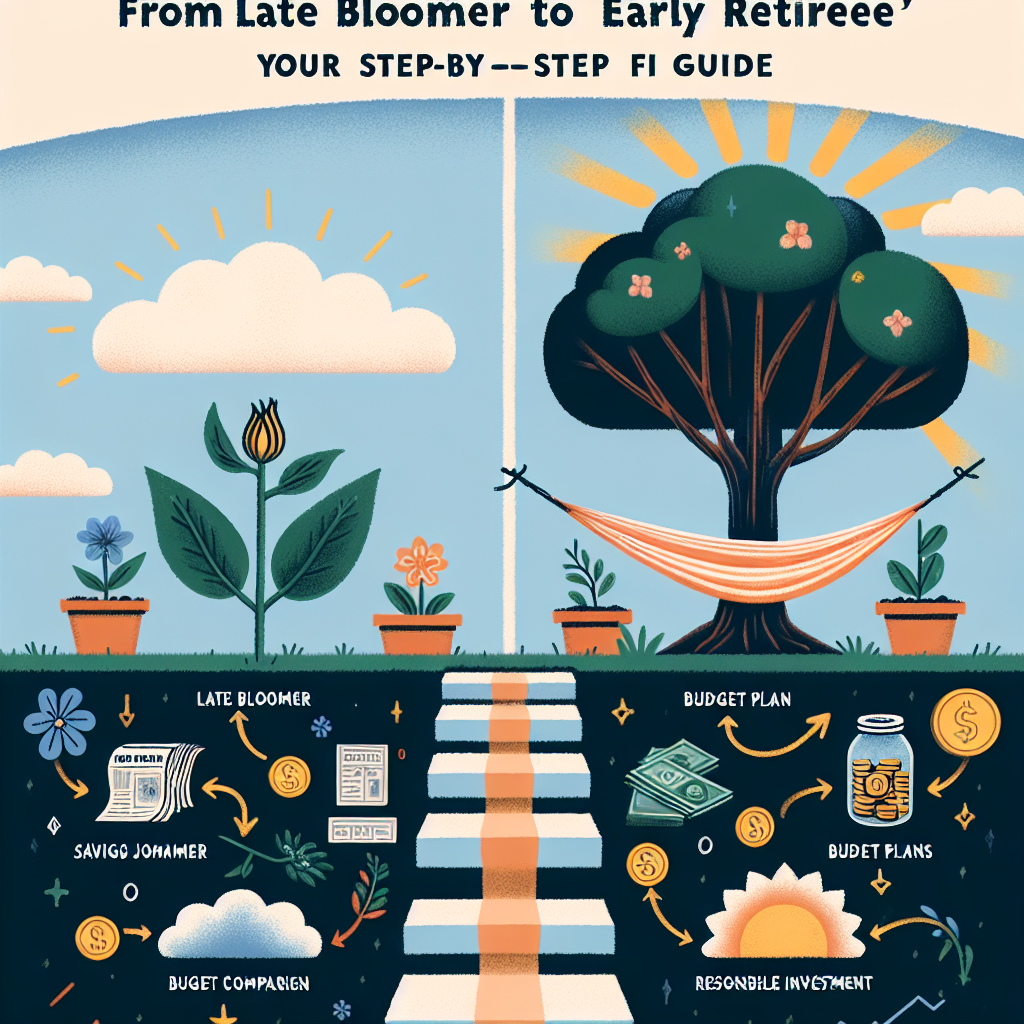-
Table of Contents
- From Late Bloomer to Early Retiree: Your Step-by-Step FI Guide
- Understanding Financial Independence
- Key Concepts of Financial Independence
- Step 1: Assess Your Current Financial Situation
- Calculate Your Net Worth
- Track Your Expenses
- Step 2: Set Clear Financial Goals
- Short-Term Goals
- Long-Term Goals
- Step 3: Create a Budget and Stick to It
- 50/30/20 Rule
- Zero-Based Budgeting
- Step 4: Increase Your Income
- Side Hustles
- Invest in Yourself
- Step 5: Save and Invest Wisely
- Retirement Accounts
- Index Funds and ETFs
- Real Estate
- Step 6: Minimize Debt
- Debt Snowball Method
- Debt Avalanche Method
- Step 7: Monitor and Adjust Your Plan
- Annual Financial Review
- Stay Informed
- Case Studies: Late Bloomers Who Achieved FI
- Case Study 1: Sarah’s Journey
- Case Study 2: John’s Transformation
- Statistics on Financial Independence
- Conclusion
From Late Bloomer to Early Retiree: Your Step-by-Step FI Guide

Financial Independence (FI) and early retirement are dreams many aspire to achieve. However, the journey can seem daunting, especially for those who consider themselves late bloomers. The good news is that it’s never too late to start. This comprehensive guide will walk you through the steps to achieve financial independence and retire early, regardless of when you begin.
Understanding Financial Independence
Before diving into the steps, it’s crucial to understand what financial independence means. Financial independence is the state of having sufficient personal wealth to live without having to work actively for basic necessities. In other words, your assets generate enough income to cover your living expenses.
Key Concepts of Financial Independence
- Passive Income: Income earned with minimal effort, such as dividends, rental income, or interest.
- Net Worth: The total value of your assets minus your liabilities.
- Safe Withdrawal Rate (SWR): The percentage of your portfolio you can withdraw annually without running out of money. A common rule of thumb is 4%.
Step 1: Assess Your Current Financial Situation
The first step towards financial independence is understanding where you currently stand. This involves evaluating your income, expenses, debts, and assets.
Calculate Your Net Worth
To calculate your net worth, list all your assets (savings, investments, property) and subtract your liabilities (debts, loans). This will give you a clear picture of your financial health.
Track Your Expenses
Understanding your spending habits is crucial. Use budgeting apps or spreadsheets to track your monthly expenses. Categorize them into needs and wants to identify areas where you can cut back.
Step 2: Set Clear Financial Goals
Setting specific, measurable, achievable, relevant, and time-bound (SMART) goals will keep you motivated and focused.
Short-Term Goals
- Build an emergency fund covering 3-6 months of living expenses.
- Pay off high-interest debt.
- Start a retirement savings account if you haven’t already.
Long-Term Goals
- Achieve a specific net worth by a certain age.
- Generate a certain amount of passive income annually.
- Retire by a specific age.
Step 3: Create a Budget and Stick to It
A budget is a financial plan that helps you manage your income and expenses. It ensures that you live within your means and save for your goals.
50/30/20 Rule
A popular budgeting method is the 50/30/20 rule:
- 50%: Needs (housing, utilities, groceries)
- 30%: Wants (dining out, entertainment)
- 20%: Savings and debt repayment
Zero-Based Budgeting
Another effective method is zero-based budgeting, where every dollar is assigned a job. This ensures that you account for every dollar of your income, leaving no room for unnecessary spending.
Step 4: Increase Your Income
While cutting expenses is essential, increasing your income can significantly accelerate your journey to financial independence.
Side Hustles
Consider taking up side hustles such as freelancing, tutoring, or driving for ride-sharing services. These can provide additional income streams.
Invest in Yourself
Investing in education and skills can lead to higher-paying job opportunities. Consider taking courses or earning certifications in your field.
Step 5: Save and Invest Wisely
Savings alone won’t get you to financial independence. Investing is crucial to grow your wealth over time.
Retirement Accounts
Maximize contributions to retirement accounts such as 401(k)s or IRAs. These accounts offer tax advantages that can boost your savings.
Index Funds and ETFs
Invest in low-cost index funds and ETFs. These funds offer diversification and have historically provided solid returns with minimal fees.
Real Estate
Consider investing in real estate for rental income and property appreciation. Real estate can be a stable and lucrative investment if managed properly.
Step 6: Minimize Debt
Debt can be a significant barrier to financial independence. Focus on paying off high-interest debt first, such as credit card debt.
Debt Snowball Method
The debt snowball method involves paying off the smallest debts first while making minimum payments on larger debts. This can provide a psychological boost and momentum.
Debt Avalanche Method
The debt avalanche method focuses on paying off debts with the highest interest rates first. This method can save you more money in interest payments over time.
Step 7: Monitor and Adjust Your Plan
Financial plans are not set in stone. Regularly review your progress and make adjustments as needed.
Annual Financial Review
Conduct an annual financial review to assess your progress towards your goals. Adjust your budget, savings rate, and investment strategy as needed.
Stay Informed
Stay informed about financial trends and investment opportunities. Continuous learning can help you make better financial decisions.
Case Studies: Late Bloomers Who Achieved FI
Let’s look at some real-life examples of late bloomers who achieved financial independence.
Case Study 1: Sarah’s Journey
Sarah started her journey to financial independence at age 45. She had minimal savings and significant debt. By following a strict budget, increasing her income through side hustles, and investing wisely, she achieved financial independence by age 60.
Case Study 2: John’s Transformation
John was a high-income earner but had poor financial habits. At age 50, he decided to change his ways. He paid off his debt, maximized his retirement contributions, and invested in real estate. John retired early at age 65 with a comfortable passive income.
Statistics on Financial Independence
Understanding the broader landscape can provide motivation and context for your journey.
- A 2020 survey by the Federal Reserve found that only 36% of non-retired adults think their retirement savings are on track.
- According to a 2019 study by the Employee Benefit Research Institute, the average retirement age in the U.S. is 62.
- The FIRE (Financial Independence, Retire Early) movement has gained popularity, with numerous online communities and resources dedicated to achieving FI.
Conclusion
Achieving financial independence and early retirement is possible, even for late bloomers. By assessing your current financial situation, setting clear goals, creating a budget, increasing your income, saving and investing wisely, minimizing debt, and regularly monitoring your progress, you can turn your financial dreams into reality. Remember, it’s never too late to start. The key is to take consistent, deliberate steps towards your goals. With determination and discipline, you can transition from a late bloomer to an early retiree.
Start your journey today and take control of your financial future. The path to financial independence may be challenging, but the rewards are well worth the effort.








